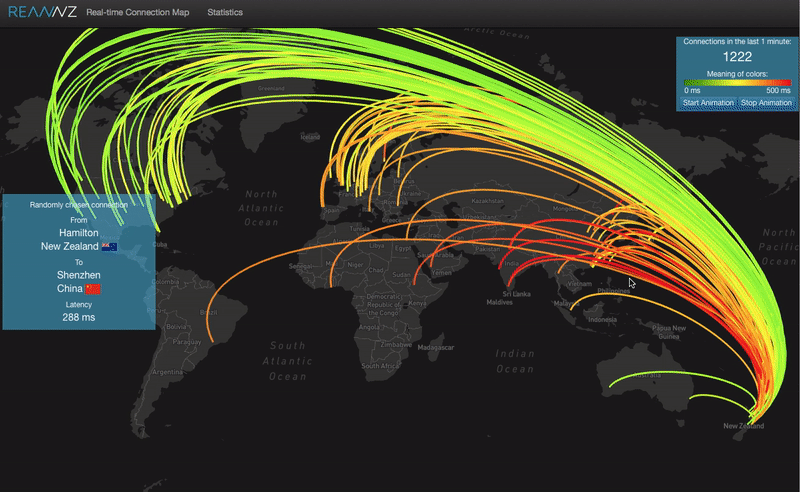czivar / Ruru
Programming Languages
Labels
Projects that are alternatives of or similar to Ruru
Ruru: real-time TCP latency monitoring
'Ruru' is a TCP latency monitoring application that helps understanding wide area TCP traffic in real time. It utilises Intel DPDK for high speed packet processing (up to 40Gbit/s) and a Node.JS web frontend to present results.
Publications, talks, podcasts
Ruru at RIPE 75: https://ripe75.ripe.net/archives/video/92/
Ruru was featured in a PacketPushers podcast: http://packetpushers.net/podcast/podcasts/pq-142-tcp-latency-monitoring-ruru/
Ruru has been published in SIGCOMM 2017. Our paper is:
[1] Cziva, R., Lorier, C. and Pezaros, D. P. (2017) Ruru: High-speed, Flow-level Latency Measurement and Visualization of Live Internet Traffic. In: SIGCOMM 2017, Los Angeles, CA, USA, 21-25 Aug 2017
High-level architecture
The system componses of three parts:
- DPDK-latency backend (written in C / multi-threaded): This software measures the elapsed time between SYN, SYN-ACK and the first ACK TCP packets for all TCP streams. It sends the measurement information (source IP, destination IP, latency (in microsecond)) on a ZMQ sockets.
- Analytics (written in C / multi-threaded): This component retrieves AS / geotag information for all IPs (using the IP2location.com databases) in the measurement data received from the DPDK backend and generates basic statistics. It pushes information in JSON format on ZMQ sockets.
- Frontend: It is a Node.js built with React and Deck.Gl. It uses socket.io to communicate with the browser.
Communication between components uses sockets (zmq and websockets). The high-level architecture is shown below.
Installation
Installation consists of the following steps:
- Install dpdk with by running ./setup.sh
- Compile dpdk-latency with make
- Set up analytics (more details in the README file of the analytics)
- Set up the frontend (more details in the README file of the frontend)
Frequently asked questions
What does Ruru mean?
Ruru is an owl from New Zealand. The bird has been selected to symbolise our software's 'intelligence' and 'clarity in the darkness'. In Māori tradition the ruru was seen as a watchful guardian. You can learn more here.
Can I deploy it? What are the license restrictions?
Ruru is free to deploy and use. The software is provided using a BSD licence that you can find in the LICENSE file.
What does Ruru measure?
It measures TCP handshakes for each individual flow: the time it takes to set up a TCP connection. It looks at TCP flags (SYN, SYN-ACK, first ACK) of the TCP packets (and nothing else).
How does Ruru figure out geographical location / ASN information for IP addresses?
Ruru uses the IP2Location.com databases for IP->ASN, IP->geolocation and IP->proxy information mapping (these are 3 different databases from IP2Location).
What processing performance does Ruru provide?
The core of Ruru (that measures the latency for each flow) is based on DPDK, therefore it can cope with up to 40Gbit/s traffic. Geo-localising each source and destination IP address takes a lot of CPU cycles, therefore it mostly depends on how powerful your host machine is. We have deployed Ruru tapping a 10Gbit/s link.
Which NICs do you support?
All DPDK supported NICs can be used for Ruru. All supported NICs can be found here: http://dpdk.org/doc/nics. We used Intel X520 NICs at REANNZ.
In case of any other questions, please contact Richard Cziva ([email protected])


